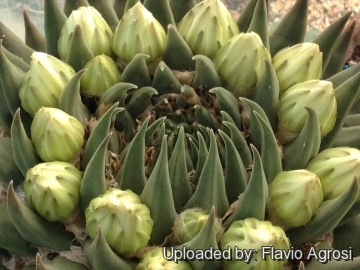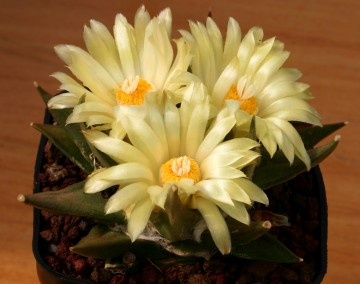Accepted Scientific Name: Ariocarpus retusus subs. trigonus (F.A.C.Weber) E.F.Anderson & W.A.Fitz Maur.
Haseltonia 5: 18. 1998 [1997 publ. 1998]

Anhalonium trigonum (Ariocarpus retusus subs. trigonus) Photo by: Prof. Ilham Alakbarov
Origin and Habitat: Mexico (Tamaulipas, Nuevo Leon)
Habitat: Grows in limestone at 600-1200 m of elevation, mostly found in colonies of considerable size, the habitat length is over 400km.
Synonyms:
See all synonyms of Ariocarpus retusus
back
Accepted name in llifle Database:Ariocarpus retusus Scheidw.Bull. Acad. Roy. Sci. Bruxelles 5: 492 (t. 1). 1838Synonymy: 31
Accepted name in llifle Database:Ariocarpus retusus subs. trigonus (F.A.C.Weber) E.F.Anderson & W.A.Fitz Maur.Haseltonia 5: 18. 1998 [1997 publ. 1998]Synonymy: 7
Cultivars
(11):
back
Common Names include:
ENGLISH: Living Rock, Star Rock
CHINESE (中文): 三角牡丹
LITHUANIAN (Lietuvių): Tribriaunis ariokarpas
SPANISH (Español): Chautle, Chaute
Description: Ariocarpus trigonusSN|2078]]SN|2094]] is one of the largest species that distinguishes for the long leaf-like triangular tubercles and peculiar yellow flowers. It is quite variable in tubercle shape and size and has received numerous unnecessary names of no botanical value, representing no more than local phenotypes
Habit: Solitary rosette-forming, geophytic cactus rising slightly above ground level.
Stem: 5 to 30 cm in diameter, 4 to 25 cm tall, globose, more or less depressed, rounded on top, mostly yellowish-green.
Tubercles: Upright yellow/brownish grey, divergent, not closely set or basally compressed, acute at the apices, flattened and smooth adaxially, not fissured, strongly incurved, 3-8cm long, 1-2.5cm broad, usually twice as long as wide, but variable from long and thin to short and broad.
Areoles: Ariocarpus trigonusSN|2079]]SN|2094]] bears only small basal areoles, whose meristem do not divide, monomorphic. On the contrary Ariocarpus retususSN|2094]]SN|2079]] has floral and spinous parts separate, dimorphic. However spine-bearing portions of the areoles are present at the tips of the tubercles of tubercles only in very small specimens.
Roots: Tap root.
Flowers: Cream-white to yellowish-white or yellow (occasionally with reddish mid-ribs) with a satin sheen, 3 to 5 cm in diameter up to 4 cm long.
Blooming season: They come in late autumn or early winter.
Fruit: Whitish or greenish, 7-20 mm long, 5-10 mm across.
Remarks: In the area of Aramberri Ariocarpus trigonusSN|2079]]SN|2094]] intergrades with Ariocarpus retususSN|2094]]SN|2079]] giving rise to a an hybrid population known as Ariocarpus confususSN|2094]]SN|2078]]
Subspecies, varieties, forms and cultivars of plants belonging to the Ariocarpus retusus group
 Ariocarpus confusus Halda & Horáček: intermediates between Ariocarpus retusus and Ariocarpus trigonus flower color, white through to magenta, a color not found in any other populations. Distribution: Aramberri region.
Ariocarpus confusus Halda & Horáček: intermediates between Ariocarpus retusus and Ariocarpus trigonus flower color, white through to magenta, a color not found in any other populations. Distribution: Aramberri region. Ariocarpus elongatus (Salm-Dyck) Wettst.: has longer an narrower tubercles than Ariocarpus retusus. Distribution: Huizache, San Luis Potosí.
Ariocarpus elongatus (Salm-Dyck) Wettst.: has longer an narrower tubercles than Ariocarpus retusus. Distribution: Huizache, San Luis Potosí. Ariocarpus furfuraceus C.H.Thomps.: has equilaterally triangular shaped tubercles.
Ariocarpus furfuraceus C.H.Thomps.: has equilaterally triangular shaped tubercles. Ariocarpus furfuraceus f. cristata Frič: crested form.
Ariocarpus furfuraceus f. cristata Frič: crested form. Ariocarpus furfuraceus f. monstruosus hort.: Free branching plants with thinner elongated stems and copious production of wool. There are several different clones.
Ariocarpus furfuraceus f. monstruosus hort.: Free branching plants with thinner elongated stems and copious production of wool. There are several different clones.- Ariocarpus furfuraceus var. rostratus A.Berger: (Ariocarpus retusus var. furfuraceus ''rostratus'') Refers to plants with a more tapered apex to the tubercle.
 Ariocarpus retusus Scheidw.: (ssp. retusus) Widespread, flowers are cream or white, occasionally with reddish midveins.
Ariocarpus retusus Scheidw.: (ssp. retusus) Widespread, flowers are cream or white, occasionally with reddish midveins. Ariocarpus retusus f. cristata hort.: is a slow-growing crested cactus forming with fan shaped stems that will slowly forms brain-shaped cushion up to 3-12 cm high and 70 cm in diameter, or more.
Ariocarpus retusus f. cristata hort.: is a slow-growing crested cactus forming with fan shaped stems that will slowly forms brain-shaped cushion up to 3-12 cm high and 70 cm in diameter, or more. Ariocarpus retusus subs. horacekii Halda & Panar.: like Ariocarpus trigonus but smaller. Distribution: South of Matehuala, San Luis Potosí.
Ariocarpus retusus subs. horacekii Halda & Panar.: like Ariocarpus trigonus but smaller. Distribution: South of Matehuala, San Luis Potosí.- Ariocarpus retusus subs. jarmilae Halda, Horáček & Panar.: nomina nuda
- Ariocarpus retusus subs. panarottoi Halda & Horáček: Nomina nuda.
 Ariocarpus retusus subs. pectinatus Weisbarth: It has, dull pectinated spines already present in young specimens up to 1,2 to 2,0 mm long. The spines persist with the age. Areoles at the tips and extending on the upper side of the tubercles, elongated 2 to 20 mm long, wooly.
Ariocarpus retusus subs. pectinatus Weisbarth: It has, dull pectinated spines already present in young specimens up to 1,2 to 2,0 mm long. The spines persist with the age. Areoles at the tips and extending on the upper side of the tubercles, elongated 2 to 20 mm long, wooly.- Ariocarpus retusus subs. scapharostroides Halda & Horáček: Plants from the Villa Juarez region of SLP, it is characterized by erect angular tubercles, superficially reminiscent of Ariocarpus scapharostrus.
- Ariocarpus retusus var. sladkovskyi Halda & Kupčák
 Ariocarpus retusus subs. trigonus (F.A.C.Weber) E.F.Anderson & W.A.Fitz Maur.: (Ariocarpus retusus ssp. trigonus) Somewhat less widespread with long sharp tubercles twice as long as wide. The flowers are yellow (usually), white to pinkish white.
Ariocarpus retusus subs. trigonus (F.A.C.Weber) E.F.Anderson & W.A.Fitz Maur.: (Ariocarpus retusus ssp. trigonus) Somewhat less widespread with long sharp tubercles twice as long as wide. The flowers are yellow (usually), white to pinkish white. Ariocarpus retusus cv. Cauliflower: has a completely or partially warty skin that gives it an aspect of cauliflower.
Ariocarpus retusus cv. Cauliflower: has a completely or partially warty skin that gives it an aspect of cauliflower.- Ariocarpus retusus cv. Cauliflower King: This is a variant of cv. cauliflower with bigger, if not huge, tubercles giving an overall appearance rather globular.
 Ariocarpus retusus cv. Frumdosus: Unlike the type species, this cultivar has not convex, bulging tubers, but flat and smooth giving them an aspect of tetrahedron.
Ariocarpus retusus cv. Frumdosus: Unlike the type species, this cultivar has not convex, bulging tubers, but flat and smooth giving them an aspect of tetrahedron.  Ariocarpus retusus cv. Frumdosus brevituberosus
Ariocarpus retusus cv. Frumdosus brevituberosus Ariocarpus retusus cv. Frumdosus f. variegata
Ariocarpus retusus cv. Frumdosus f. variegata Ariocarpus retusus cv. Maruibo: Unlike the type species that has more or less triangular tubers, here they take a round shape and looks like small spheres ending with a large woolly areolae.
Ariocarpus retusus cv. Maruibo: Unlike the type species that has more or less triangular tubers, here they take a round shape and looks like small spheres ending with a large woolly areolae. Ariocarpus retusus cv. Maruibo Cauliflower: A pretty good combination of "Maruibo" and "Cauliflower" character.
Ariocarpus retusus cv. Maruibo Cauliflower: A pretty good combination of "Maruibo" and "Cauliflower" character. Ariocarpus retusus cv. Maruibo Pectinatus: is characterized by the swollen tubercles of "Maruibo" together with the very woolly and sometimes prickly central groove of "Pectinatus".
Ariocarpus retusus cv. Maruibo Pectinatus: is characterized by the swollen tubercles of "Maruibo" together with the very woolly and sometimes prickly central groove of "Pectinatus". Ariocarpus retusus cv. Mituibo: (a.k.a. cv. Three Finger or Tresfinger)The tip of each tubercles is split into three points as three fingers, a bit like a trident with a large central section and two smaller ones on each side.
Ariocarpus retusus cv. Mituibo: (a.k.a. cv. Three Finger or Tresfinger)The tip of each tubercles is split into three points as three fingers, a bit like a trident with a large central section and two smaller ones on each side. Ariocarpus retusus cv. Tama Botan: (a.k.a. Ariocarpus retusus var. major) It is a cultivated selection with very wide leaflike, divergent tubercles. The tubercles are 3,5 to 5 cm wide, and are as wide as long or wider in adult specimens.
Ariocarpus retusus cv. Tama Botan: (a.k.a. Ariocarpus retusus var. major) It is a cultivated selection with very wide leaflike, divergent tubercles. The tubercles are 3,5 to 5 cm wide, and are as wide as long or wider in adult specimens.
Bibliography: Major references and further lectures
1) Edward Anderson “The Cactus family” Timber Press, Incorporated, 2001
2) Del Weniger “Cacti of the Southwest: Texas, New Mexico, Oklahoma, Arkansas, and Louisiana” University of Texas Press, 1969
3) James Cullen, Sabina G. Knees, H. Suzanne Cubey "The European Garden Flora Flowering Plants: A Manual for the Identification of Plants Cultivated in Europe, Both Out-of-Doors and Under Glass" Cambridge University Press, 11/Aug/2011
4) David R Hunt; Nigel P Taylor; Graham Charles; International Cactaceae Systematics Group. "The New Cactus Lexicon" dh books, 2006
5) Urs Eggli, Leonard E. Newton: “Etymological Dictionary of Succulent Plant Names” Springer, Berlin/Heidelberg 2010
6) N. L. Britton, J. N. Rose: “The Cactaceae. Descriptions and Illustrations of Plants of the Cactus Family.” Volume III, The Carnegie Institution of Washington, Washington 1922
7) E. F. Anderson and W. A. Fitz Maurice "Ariocarpus revisited." Haseltonia 5: 1-20. 1997).
8) Anderson, E. F. "Ariocarpus: Some reminiscences." Cart. Succ. J. (US) 71:180-190, 1999)
9) Stuart Max Walters “The European garden flora. 3.[Angiospermae], Dicotyledons. [Casuarinaceae to Aristolochiaceae]” Cambridge University Press, 1989
 Anhalonium trigonum (Ariocarpus retusus subs. trigonus) Photo by: Flavio Agrosi
Anhalonium trigonum (Ariocarpus retusus subs. trigonus) Photo by: Flavio Agrosi Anhalonium trigonum (Ariocarpus retusus subs. trigonus) Photo by: Flavio Agrosi
Anhalonium trigonum (Ariocarpus retusus subs. trigonus) Photo by: Flavio Agrosi Anhalonium trigonum (Ariocarpus retusus subs. trigonus) Photo by: Valentino Vallicelli
Anhalonium trigonum (Ariocarpus retusus subs. trigonus) Photo by: Valentino Vallicelli A young (6 years old) specimen of A. trigonus (KMR 46 North-West of Palmillas, Tamaulipas, Mexico) (Ariocarpus retusus subs. trigonus) Photo by: Cactus Art
A young (6 years old) specimen of A. trigonus (KMR 46 North-West of Palmillas, Tamaulipas, Mexico) (Ariocarpus retusus subs. trigonus) Photo by: Cactus Art Anhalonium trigonum (Ariocarpus retusus subs. trigonus) Photo by: Andrea B.
Anhalonium trigonum (Ariocarpus retusus subs. trigonus) Photo by: Andrea B. Anhalonium trigonum (Ariocarpus retusus subs. trigonus) Photo by: Cactus Art
Anhalonium trigonum (Ariocarpus retusus subs. trigonus) Photo by: Cactus Art Anhalonium trigonum (Ariocarpus retusus subs. trigonus) Photo by: Valentino Vallicelli
Anhalonium trigonum (Ariocarpus retusus subs. trigonus) Photo by: Valentino Vallicelli Ariocarpus trigonus, San Jose de Salamanca, Tamaulipas. (Ariocarpus retusus subs. trigonus) Photo by: Amante Darmanin
Ariocarpus trigonus, San Jose de Salamanca, Tamaulipas. (Ariocarpus retusus subs. trigonus) Photo by: Amante DarmaninCultivation and Propagation: This species is slow-growing, but certainly not as slow as some other types of cacti. It is of easy cultivation in a well drained, non-organic, free-draining soil compost, with ample water during the growing season. Use of a weak low-nitrogen fertilizer during the growing season can encourage growth. The main threat to their development is root rot. Ariocarpus should be kept dry whenever there is a threat of cold. The appearance of Ariocarpus can benefit greatly by watering the plants from the bottom. This practice will help to keep the “wool” on the top of the plant from becoming matted or discoloured. Needs light shade to full sun. Frost Tolerance: Hardy to -10° C.
Propagation: It is probably the easiest species of the genus to raise from seed, but will generally take about 7-10 years to reach flowering size, occasionally grafted.
Your Photos

by Valentino Vallicelli

by Cactus Art

by Valentino Vallicelli

by Valentino Vallicelli

by Valentino Vallicelli























